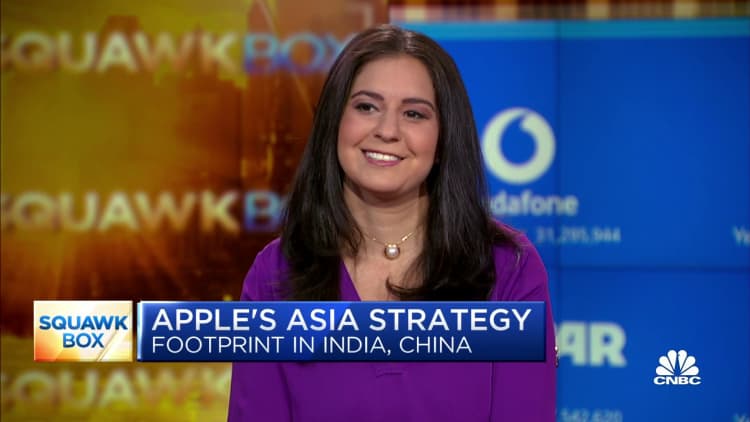[ad_1]
A view of Apple’s first company-owned store in India to be launched inside the Jio World Drive mall at Bandra Kurla Complex (BKC) in Mumbai.
Ashish Vaishnav | Sopa Images | Lightrocket | Getty Images
Apple on Tuesday opened its first store in India, highlighting the importance of the market to the iPhone maker’s future.
The first store, called Apple BKC, is located in the populous city of Mumbai. Apple on Thursday will open another store in the capital of Delhi.
The Cupertino giant said it has been present in India for more than 25 years.
“India has such a beautiful culture and an incredible energy, and we’re excited to build on our long-standing history,” Apple CEO Tim Cook said in a press release published Monday.
Cook posted a photo of himself and staff at the new apple store on Monday.
Apple is aiming to boost sales and manufacturing of iPhones in India in a move analysts say resembles its strategy when it first entered China, now one of the company’s biggest markets.
Apple claims its Mumbai store is “one of the most energy-efficient” locations in the world and has a dedicated solar energy system and has zero reliance on fossil fuels for the store’s operations. Apple BKC runs on 100% renewable energy, Apple said.
Cook has long viewed India as a key market to Apple’s future and in February he said he was “bullish” on the world’s fifth-largest economy and the company is putting a “significant amount of energy” into the market. Cook traveled to India for the opening of the store, nearly seven years after his first visit as Apple CEO.
India’s smartphone market, however, has been dominated in recent years by Samsung and Chinese brands such as Xiaomi, with low-to-mid-tier priced devices finding support from customers in a price-sensitive market. Apple has very little market share in India.
But India is undergoing a “premiumification of market,” according to Neil Shah, partner at Counterpoint Research. Smartphones priced above $400 now account for 10% of the total volumes of handsets shipped versus 4% before the pandemic, according to Shah. He said this category of smartphones accounts for 35% of total smartphone market revenue.
“Apple as usual has got the timing right on ‘peaking at the right time’ with its flagship store strategy to catalyse this trend in its favour,” Shah told CNBC via email.
India has a growing middle class, a young and “mobile first” population willing to pay more for phones, especially in Mumbai and Delhi, two of the country’s wealthiest cities and the location of the new Apple stores.
iPhone sales in focus
Apple’s India push offers the opportunity for the U.S. technology giant to boost revenue and iPhone sales near the levels seen in markets like the U.S. and China, analysts said.
Apple shipped about 6.5 million iPhones in India in 2022, compared to around 50 million each year in both the U.S. and China, according to Counterpoint Research. Shah said India “has the potential to reach that scale” in the coming years.
Shipments refer to the iPhones Apple sends to retailers but do not equal sales. However, it is an indicator of the demand for iPhones in a country.
Apple made $6 billion in revenue in the year through to March, growing 50%, Bloomberg reported on Monday, citing a person familiar with the matter.
Dan Ives, analyst at Wedbush Securities, said that could rise further over the next two years.
“Apple is now aggressively looking at India from both a production and retail expansion over the coming years that we believe will be a strategic poker move for Cupertino that could ramp annual revenue to $20 billion by 2025 in India,” Ives said in a note published Tuesday.
But it’s not just about selling iPhones. Apple’s strategy over the years has involved getting users locked into its suite of products including the Apple Watch and services like Apple Music.
“Apple can cross sell other products such as Macs, Watch, AirPods, iPads and services to the growing iPhone user base maximising the revenue opportunity,” Shah said.
Manufacturing push
For Apple, India also represents a key part of its manufacturing strategy for the future.

Part of the move in India is tied to the government’s push to bring high-tech manufacturing to the country. But Apple is also trying to diversify its assembly of products away from China. Supply chain fragilities in the world’s second-largest economy were exposed during the Covid pandemic and the strict measures Beijing took to control the outbreak.
Production was disrupted last year at Apple’s biggest iPhone factory, located in Zhengzhou, China, by a Covid outbreak and worker protests. That factory is run by the Taiwanese firm Foxconn.
Wedbush’s Ives said Apple’s India strategy — with both a retail and manufacturing push — mirrors the technology giant’s steps it took in the China market 10 years ago.
“As Foxconn/Apple put more skin in the game on the iPhone production front within India this will go hand in hand with a bigger retail presence within India as seen this week which mirrors the early days of the China penetration strategy going back a decade,” Iva said.
“Rome was not built overnight and neither will Apple’s broader India strategy, however, we view this week as Apple diving into the deep end of the pool in India as this massive market slowly converts into the Apple ecosystem over the coming years with iPhone market share gains front and center.”
[ad_2]

